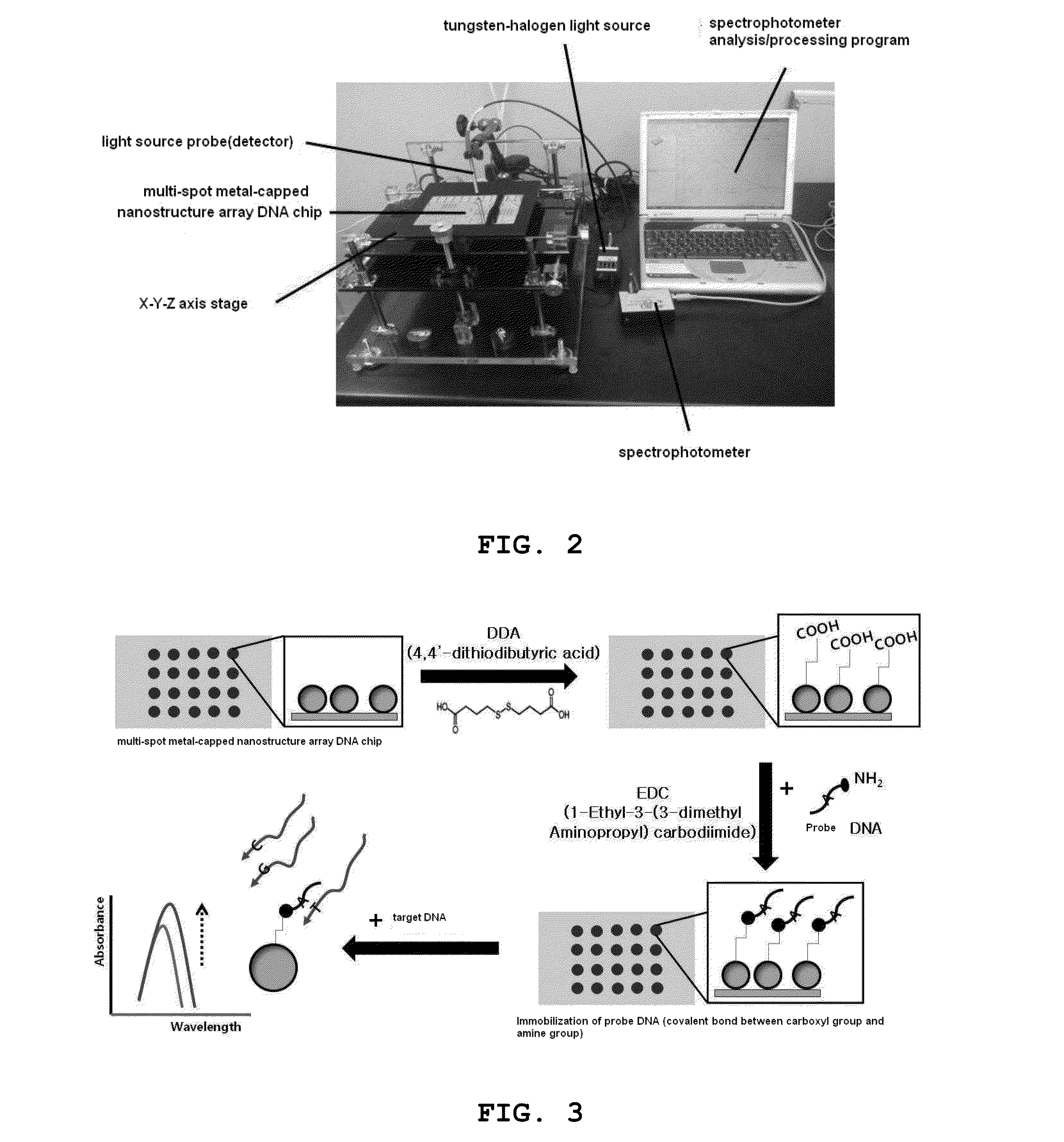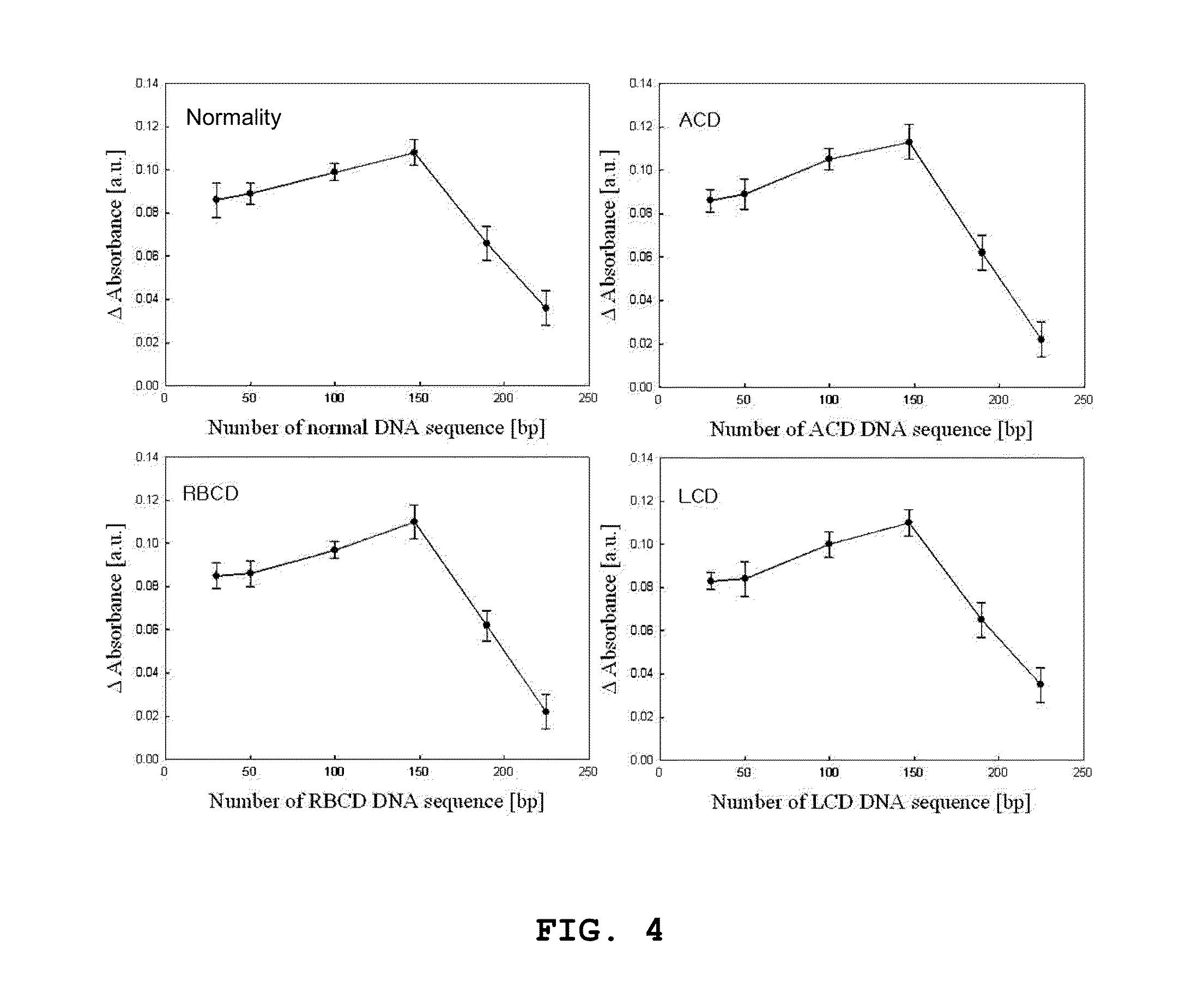Multi-spot metal-capped nanostructure array nucleic acid chip for diagnosing of corneal dystrophy and preparation method thereof producing same
a nanostructure array and nucleic acid chip technology, applied in the direction of nucleotide libraries, library screening, library creation, etc., can solve the problems of loss of sight, labeling operation, difficult to perform a simple and easy measurement,
- Summary
- Abstract
- Description
- Claims
- Application Information
AI Technical Summary
Benefits of technology
Problems solved by technology
Method used
Image
Examples
example 1
Preparation of Multi-Spot Metal-Capped Nanostructure Array Nucleic Acid Chip for Diagnosing Corneal Dystrophy
[0060]Each of chromium and gold was vacuum-deposited on the surface of a slide glass substrate (first layer; 75 mm×25 mm×1 mm) using a vacuum deposition system (Shinu MST Co., Ltd., Korea), thereby forming a gold thin film layer (second layer). Specifically, chromium as the intermediate metal thin film was deposited to a thickness of 5 nm, and the thickness of the gold thin film layer could be controlled to 40 nm. Then, a porous mask (15, 20, 60 or 140 spots) was fixed to the gold thin film layer (second layer) by adsorption. Then, on the surface of the gold thin film layer (second layer) having the porous mask adsorbed thereon, an SAM film was formed using 1 mM 4,4′-dithiodibutylic acid (DDA). Then, 400 mM EDC was added to the surface of the gold thin film layer (second layer), and activation of the carboxyl group introduced onto the surface was performed, after which 100-nm...
example 2
Construction of LSPR Optical Property-Based Label-Free Optical Biosensor Comprising Multi-Spot Metal-Capped Nanostructure Array Nucleic Chip for Diagnosing Corneal Dystrophy
[0061]FIG. 2 shows a photograph of an LSPR optical property-based label-free optical biosensor comprising the multi-spot metal-capped nanostructure array nucleic chip for diagnosing corneal dystrophy prepared as described above. The LSPR optical property-based label-free optical biosensor comprising the multi-spot metal-capped nanostructure array nucleic chip for diagnosing corneal dystrophy comprises a tungsten-halogen light source (wavelength: 360 nm-2000 nm, Ocean Optics, Inc., USA), a detector (wavelength: 300 nm-1100 nm, Ocean Optics, Inc., USA), a spectrophotometer (wavelength: 200 nm-1100 nm, Ocean Optics, Inc., USA) for splitting the light detected by the detector, and an analysis / processing program (Ocean Optics, Inc., USA) for processing the results obtained in the spectrophotometer. Herein, the tungste...
example 3
Determination of BIGH3 Gene Mutation Type
[0062]In order to construct a probe for diagnosing a mutation in the BIGH3 gene (National Center for Biotechnology Information, NCBI accession no. NM—000358) responsible for ocular diseases, including Avellino corneal dystrophy, BIGH3 gene mutation sites to be used for the construction of the probe were determined. The DNA base sequences and amino acid sequences of the BIGH3 gene mutation sites were analyzed and secured through the NCBI gene-related database GenBank and OMIM (Online Mendelian Inheritance in Man), and information on each allele was also secured. To test the effectiveness of the diagnosis chip, mutation types to be searched were first determined. Among BIGH3 gene hot spots, mutation spots causing Avellino corneal dystrophy (ACD), lattice type I corneal dystrophy (LCD) and Reis-bucklers corneal dystrophy (RBCD) were selected (Table 1). mutation region of the exon 4 region
TABLE 1Ocular diseases for BIGH3 gene mutationsExonAmino a...
PUM
| Property | Measurement | Unit |
|---|---|---|
| thickness | aaaaa | aaaaa |
| thickness | aaaaa | aaaaa |
| thicknesses | aaaaa | aaaaa |
Abstract
Description
Claims
Application Information
 Login to View More
Login to View More - R&D
- Intellectual Property
- Life Sciences
- Materials
- Tech Scout
- Unparalleled Data Quality
- Higher Quality Content
- 60% Fewer Hallucinations
Browse by: Latest US Patents, China's latest patents, Technical Efficacy Thesaurus, Application Domain, Technology Topic, Popular Technical Reports.
© 2025 PatSnap. All rights reserved.Legal|Privacy policy|Modern Slavery Act Transparency Statement|Sitemap|About US| Contact US: help@patsnap.com



